They are dubbed the “craziest” creation of nature.
When we think of insects, most of us envision tiny, hardworking creatures that lead very disciplined lives. Bees wake up early to gather nectar, ants line up in long queues to carry food back to their nests before winter…
Even spiders—the ones often considered the laziest in the insect world—must stay up all night to weave their webs if they want to lounge around all day waiting for a meal to come to them.
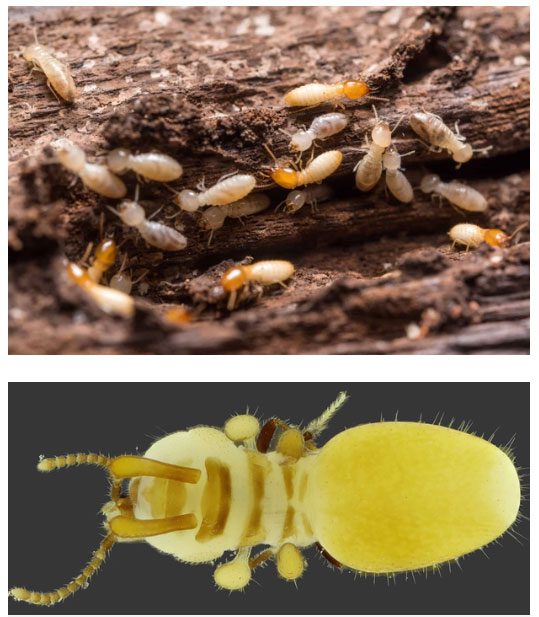
The Austrospirachtha carrijoi beetles were discovered as a completely new species. At first glance, they look very much like termites, but be careful not to be deceived by them. (Photo: Science).
However, in a recent study published in the journal Zootaxa, Australian scientists have discovered a completely new species of insect, a creature that is even lazier than spiders.
The Austrospirachtha carrijoi beetles do nothing yet still want to be fed. To achieve this, they have transformed themselves into tricksters with exceptionally sophisticated deception tactics.
Tragically, the targets of these beetles are the blind termites.
The “craziest” masquerade of creation
The journal Science had to use the term “crazy” to describe how the A. carrijoi beetles deceive not only the researchers but also the termites.
These cunning creatures were accidentally discovered during a field survey by a group of biologists from the University of São Paulo, Brazil. They traveled halfway around the world to northern Australia, known for its incredibly diverse insect populations.
The research team initially aimed to study termite mounds, massive structures filled with thousands of tiny, milky-white creatures—sometimes becoming a source of entertainment for the local Australian people.
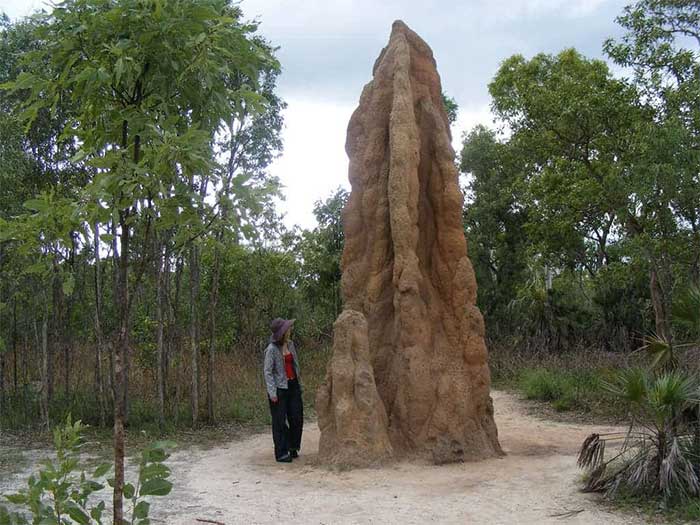
Inside these giant termite mounds in Australia lies one of the “craziest” creations of nature. They look just like termites but are not termites. (Photo: ZMEscience).
While digging deeper into the castle-like structures of the termites, scientists occasionally found a very strange termite specimen. From above, it looked exactly like a termite with a plump abdomen, a narrow waist, and two antennae protruding from the front of its head.
But beware of being deceived. When scientists looked at the cross-section, they discovered another body protruding beneath this termite—another head and two antennae. It turned out that this was the real creature.
The entire termite-shaped figure they saw above was just a decoy. It was a puppet, a giant model built to resemble the deity procession of the Hakka people in China.
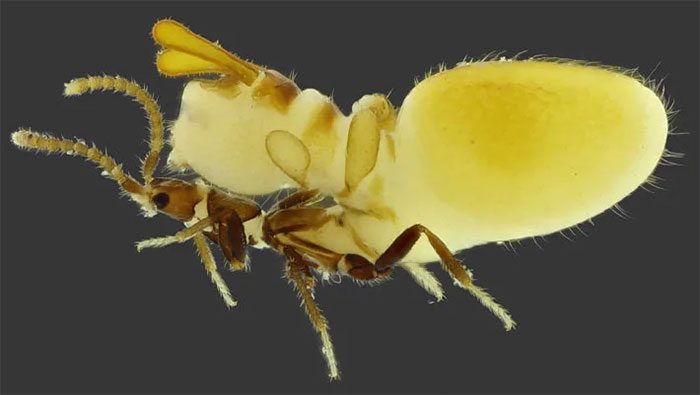
When scientists looked at the cross-section, they discovered another body protruding beneath this termite—another head and two antennae. It turned out that this was the real creature. The entire termite-shaped figure they saw above was just a decoy. (Photo: Science).
Immediately after observing the strange creature, Brazilian researchers captured them for study. DNA analysis revealed that this creature belonged to the Staphylinidae family and not termites. They are closely related to the Austrospirachtha mimetes species found in Brazil.
With these characteristics, scientists named it Austrospirachtha carrijoi, with “carrijoi” being the name of Dr. John Carrijo, the Brazilian entomologist who directly traveled to Australia to collect specimens.
Further research revealed that the A. carrijoi beetle only has its lower body as real. The entire upper body resembling a termite is actually a balloon-like extension from its abdomen, a phenomenon referred to as “physogastry” in the insect world.
In this context, queen ants or queen bees often have a physogastry extension from their abdomen to hold eggs. Soldier termites and worker termites also commonly possess this swollen abdomen to store more food.
Only certain beetle species have evolved to turn their swollen abdomen into a deception tool.
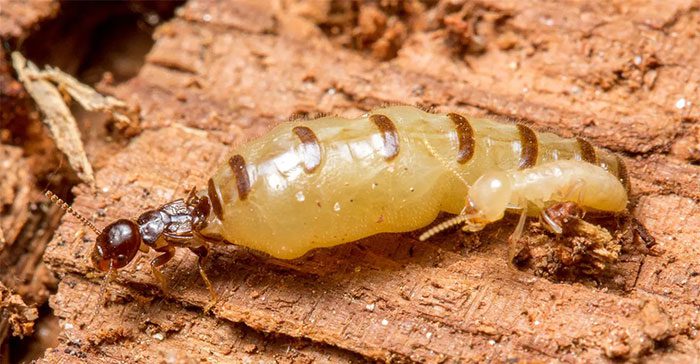
Physogastry is the enlarged abdomen of insects. Termites and ants often use it to hold eggs or food. Only beetle species have developed these false abdomens for deception. (Photo: Science).
To do nothing and still get fed
In a previous study published in the journal Current Biology, scientists constructed a phylogeny consisting of 180 beetle species worldwide.
They found that at many independent locations, geographically distant from each other, various beetle species employed a common evolutionary formula. After more than 100 million years, through 12 to 15 evolutionary rounds, these beetles transformed their physogastry abdomen into a fake puppet, resembling indigenous ants.
This process is referred to as “convergent evolution,” where different organisms evolve in a similar manner if they live in environments with similar natural selection pressures.
“One of the main survival challenges for beetles living in tropical rainforests is that they must coexist with huge colonies of army ants, notorious for their aggressiveness and frequent raiding,” said Joseph Parker, a postdoctoral researcher at Columbia University.
“Many beetle species have thus accidentally discovered an incredible strategy. They can rush directly into the most dangerous areas, blend in with the ants to enter their nests, and then consume them.”
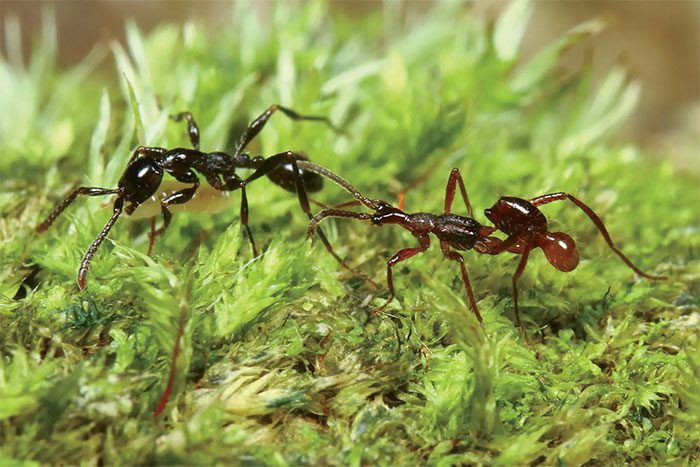
In this photo, can you distinguish between the ant and the beetle masquerading as an ant? Answer: On the right is the beetle with a fake ant body growing from its abdomen. On the left is the army ant unaware of the impersonator. (Photo: Science).
So these beetles have grown an ant-like body on their backs. They also secrete chemicals called pheromones that army ants typically produce. Once inside the ant nest, the beetles will eat the ant larvae to survive.
For the newly discovered A. carrijoi beetles, scientists noted that they have chosen a gentler and more pitiable victim than army ants. That is the blind termites.
Termites lack visual organs and are often described as “blind.” However, they have developed very sensitive sensory organs on their legs to touch their kind and recognize them.
Perhaps this is why A. carrijoi must develop its false abdomen with great precision. Compared to beetles impersonating army ants, the A. carrijoi masquerading as termites is a far more perfect replica.
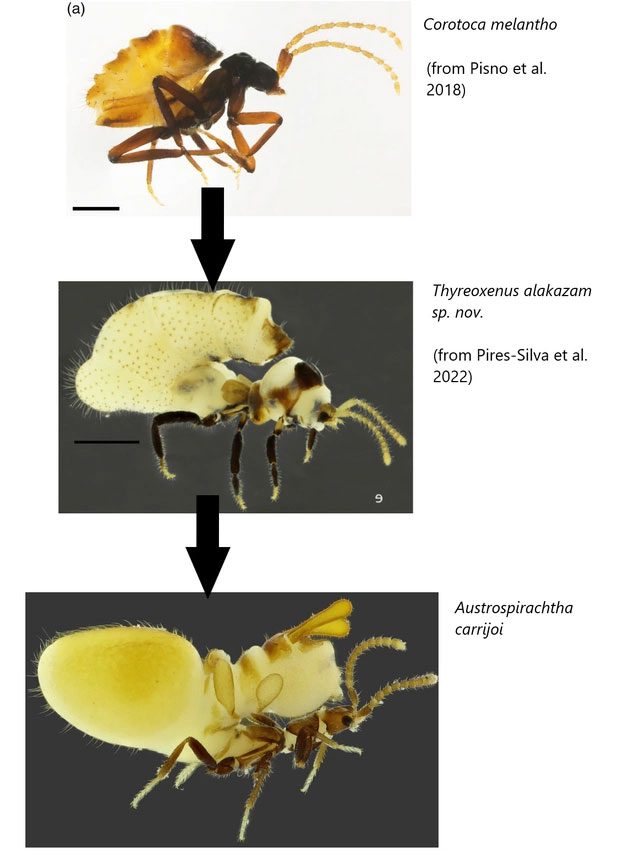
Other beetle species often develop false abdomens to blend in with other insect colonies. But no species has developed false abdomens with antennae like A. carrijoi. (Photo: Science).
It has three false parts, mimicking three segments of a termite, including the abdomen, thorax, and head. No beetle species has developed false abdominal parts with antennae like A. carrijoi.
Of course, these A. carrijoi beetles also secrete hydrocarbon chemicals similar to those of termites to deceive them. The goal, according to scientists, is to have the termites feed them.
Termites often feed each other through a process known as “trophallaxis.” In these “kisses,” they transfer food orally from one individual to another. Therefore, if a termite mistakenly identifies A. carrijoi as one of its own, it may feed the beetle without suspicion.
By employing their cunning impersonation strategy, an A. carrijoi can comfortably reside in a termite nest for life, enjoying free meals served by the termites.
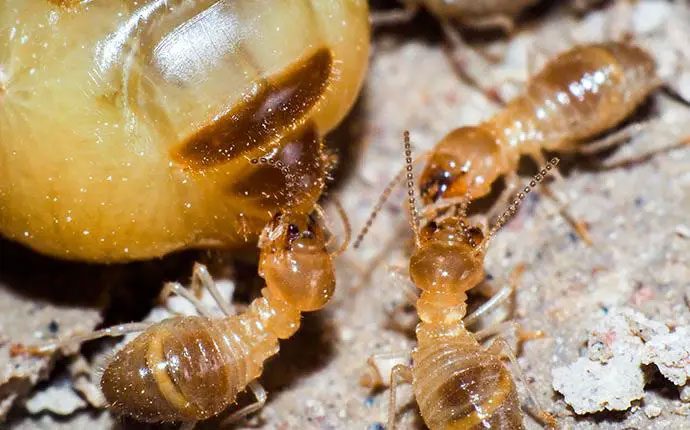
Termites often feed each other through such “kisses.” They transfer food orally to their kind and to the queen termite. The A. carrijoi beetles have exploited this to survive in termite nests by impersonating them.
What Happens If They Are Discovered?
This is the question that scientists have posed regarding Austrospirachtha carrijoi and its beetle relatives that mimic army ants. For A. carrijoi, due to their very small mouthparts, the authors of the study suggest that they only scavenge from termites and do not have the capability to eat termite eggs or larvae.
Termites are also much less aggressive than army ants. They primarily consume wood, fungi, or bacteria and do not eat other animal species. Termites lack any offensive techniques against enemies, focusing instead on defense and retreat.
Therefore, if A. carrijoi is discovered in a termite nest, it likely would not face any life-threatening danger. However, the beetles that have the audacity to mimic army ants are a different story.
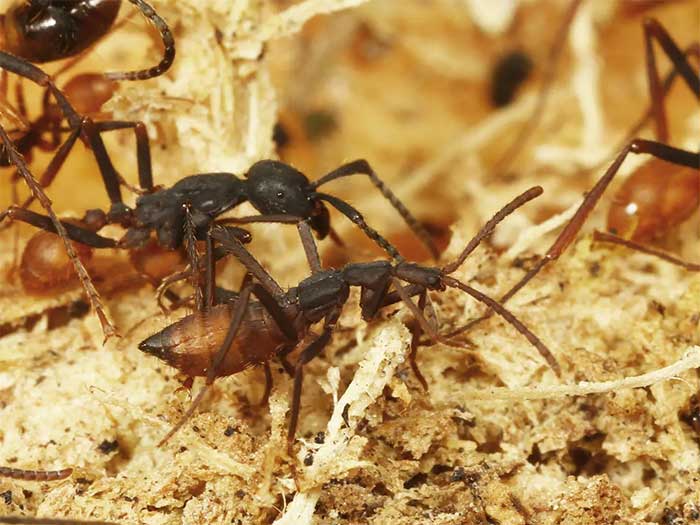
A beetle (below) caught while mimicking army ants (above) right in their nest. (Photo: Eurekalert).
These beetles have been calmly feeding on ant eggs and larvae right within the ant nest. Army ants are known for their aggressive nature. They can secrete venom containing formic acid to kill bees, grasshoppers, or other ants.
A swarm of army ants attacking simultaneously can kill a mouse, frog, or large insect.
In their study, scientists noted that a beetle living in an army ant nest is typically surrounded by 5,000 ants. Therefore, if the beetle is caught consuming ant larvae or eggs, the ants would likely kill it immediately.
This could be a fitting end for a freeloading creature that seeks to benefit without contributing.


















































